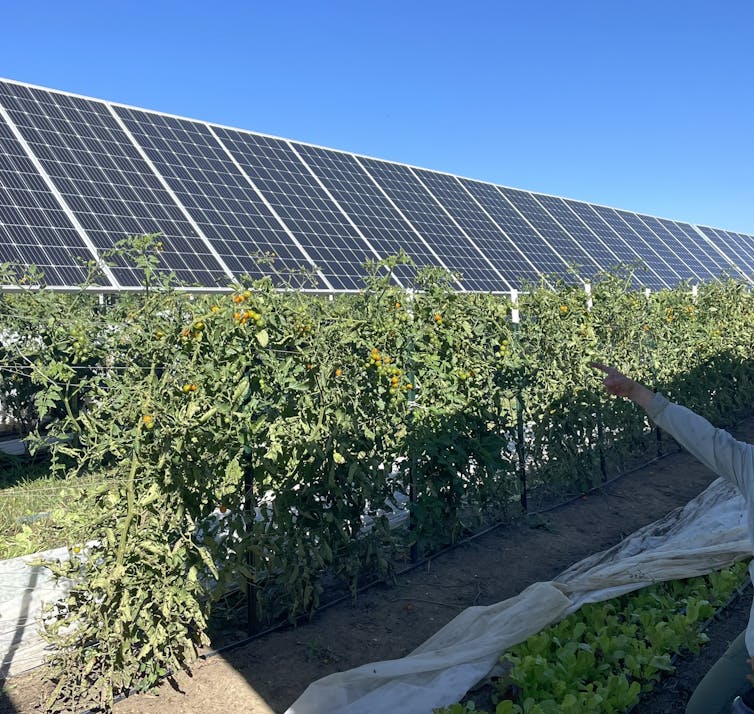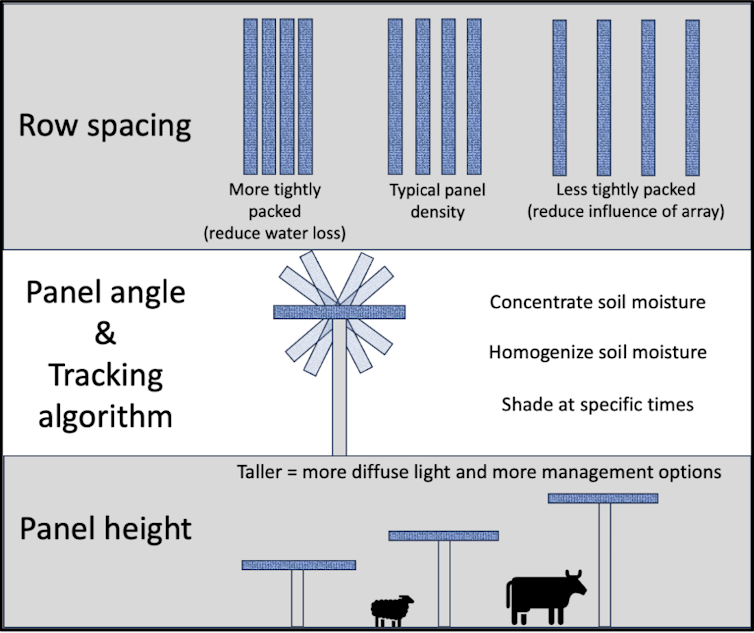Matthew Sturchio, Colorado State University
As societies look for ways to cut greenhouse gas emissions and slow climate change, large-scale solar power is playing a central role. Climate scientists view it as the tool with the greatest potential to reduce carbon dioxide emissions by 2030. In the U.S., the Department of Energy predicts that solar will account for nearly 60% of all new utility-scale electricity-generating capacity installed in 2024.
But ideal locations for solar development often overlap with croplands or grasslands used for livestock grazing. Typically, large-scale solar arrays are designed to maximize energy generation, without much consideration for the ecosystems in which they are placed.
For example, grading land and removing vegetation can cause erosion and send runoff into waterways. Solar developers have been fined for such environmental violations in Georgia, Massachusetts, Alabama, Idaho and Illinois.
There also are concerns about how large solar installations affect animal movement patterns. In the western U.S., removing native vegetation to make room for solar farms can threaten endangered animals and insects that rely on these plants as food and habitat. Native plant communities take a long time to reestablish themselves in these water-limited areas after they are disturbed.
I am an ecologist and a member of a research team led by Alan Knapp at Colorado State University. We investigate how solar development affects grassland ecosystem health – in particular, how plants’ growth and water use patterns and response to light change once solar panels are installed overhead. Through this work, we hope to inform a more sustainable future for solar energy.

Matthew Sturchio, CC BY-ND
Two land uses are better than one
A growing alternative to using land solely for solar power generation is called agrivoltaics. As its name suggests, this strategy combines agriculture and solar power on the same piece of land. Agrivoltaic projects can take place on croplands, grazing lands and habitat for agriculturally important pollinators. This dual-use approach to solar development has become popular worldwide
The vast majority of agrivoltaic projects in the U.S. are on lands managed for livestock grazing and pollinator habitat. These sites are ideal for solar power colocation because, unlike croplands, they do not require irrigation or the use of large machinery.
However, these lands rely on rainfall to support plant growth, and the presence of solar panels affects how water reaches the soil. Most agrivoltaic arrays use sun-tracking programs that maximize energy production by tilting panels to follow the sun across the sky. As this happens, the panels create distinct micro-environments that are quite different from natural conditions.
For example, in Colorado, most precipitation occurs in the afternoon, when solar panels are tilted west toward the sun. As a result, most rainfall on agrivoltaic sites is concentrated at the panels’ western edges where it drops to the ground. This redistribution can multiply rainfall at panel edges by up to a factor of four, while restricting rainfall in other patches.
Another factor is that solar panels introduce shade on grasslands that are adapted to high light conditions. Because the arrays are optimized to intercept sunlight, much less light reaches plants beneath the panels.
The ecology behind ecovoltaics
So far, our work shows that the distinct micro-environments created by solar arrays produce similarly varied patterns of plant growth. This finding is encouraging: It means that the environmental variation created by solar panels passively tracking the sun is enough to make plants respond differently. These micro-environments could potentially support a mosaic of plant communities that benefit from different conditions.
In some cases, mixed conditions like these, with varying levels of light and water, can be a good thing. A well-tested concept in restoration ecology – the science of restoring damaged ecosystems – is that environments with more variety support more diverse mixes of plants and animals.
In a 2023 paper, we outlined a concept that calls for an ecologically informed approach to solar development. This approach, called ecovoltaics, requires giving equal priority to energy production and ecosystem services.
An ecovoltaic approach allows land managers to use solar to their advantage. Designing and managing solar arrays in ways that are rooted in fundamental ecological concepts can produce more synergies between ecosystems and solar energy.

Matthew Sturchio, CC BY-ND
Land managers could use ecovoltaic approaches to improve degraded lands by designing solar arrays to enhance natural processes. For example, since the edges of solar panels redistribute and concentrate rainfall, making the soil beneath them wetter, they could aid in seedling establishment in those spots.
In arid regions, arrays could be designed to promote this effect and improve restoration. If water is scarce, arrays could be designed to reduce the amount of exposed ground, which in turn would reduce the amount of water lost to the atmosphere through evaporation.
Doing solar differently
Many factors influence land management decisions. The land’s history, access to water, soil types, vegetation and topography all play a role. Ecovoltaics adds another factor: balancing energy production per unit area with the ecological effects of a particular solar array.
An ecovoltaic approach to solar power requires fundamentally rethinking how solar development decisions are made. Today, access to electricity transmission lines limits where solar power can be deployed in many areas. If transmission lines and substations are too far away, or undersized, solar power is unlikely to be developed.
New transmission projects that ease this geographic constraint could provide more options. With greater flexibility in choosing sites, developers could shift away from highly sensitive natural ecosystems and install solar arrays on abandoned, water-limited or otherwise degraded lands instead. Ecovoltaics could be a solution for stabilizing the economy of communities where productive land has been retired to conserve resources
Solar power is scaling up to levels that make it central to a clean energy transition. My colleagues and I believe that solar development should proceed in a way that reflects ecological thinking. In our view, an ecovoltaic approach to solar can produce positive ecological outcomes and make solar energy even more sustainable.![]()
Matthew Sturchio, PhD Student in Plant and Ecosystem Ecology, Colorado State University
This article is republished from The Conversation under a Creative Commons license. Read the original article.
***
Author
Matthew Sturchio
PhD Student in Plant and Ecosystem Ecology, Colorado State University
Disclosure statement
Matthew Sturchio receives funding from the US Department of Agriculture’s National Institute of Food and Agriculture.










